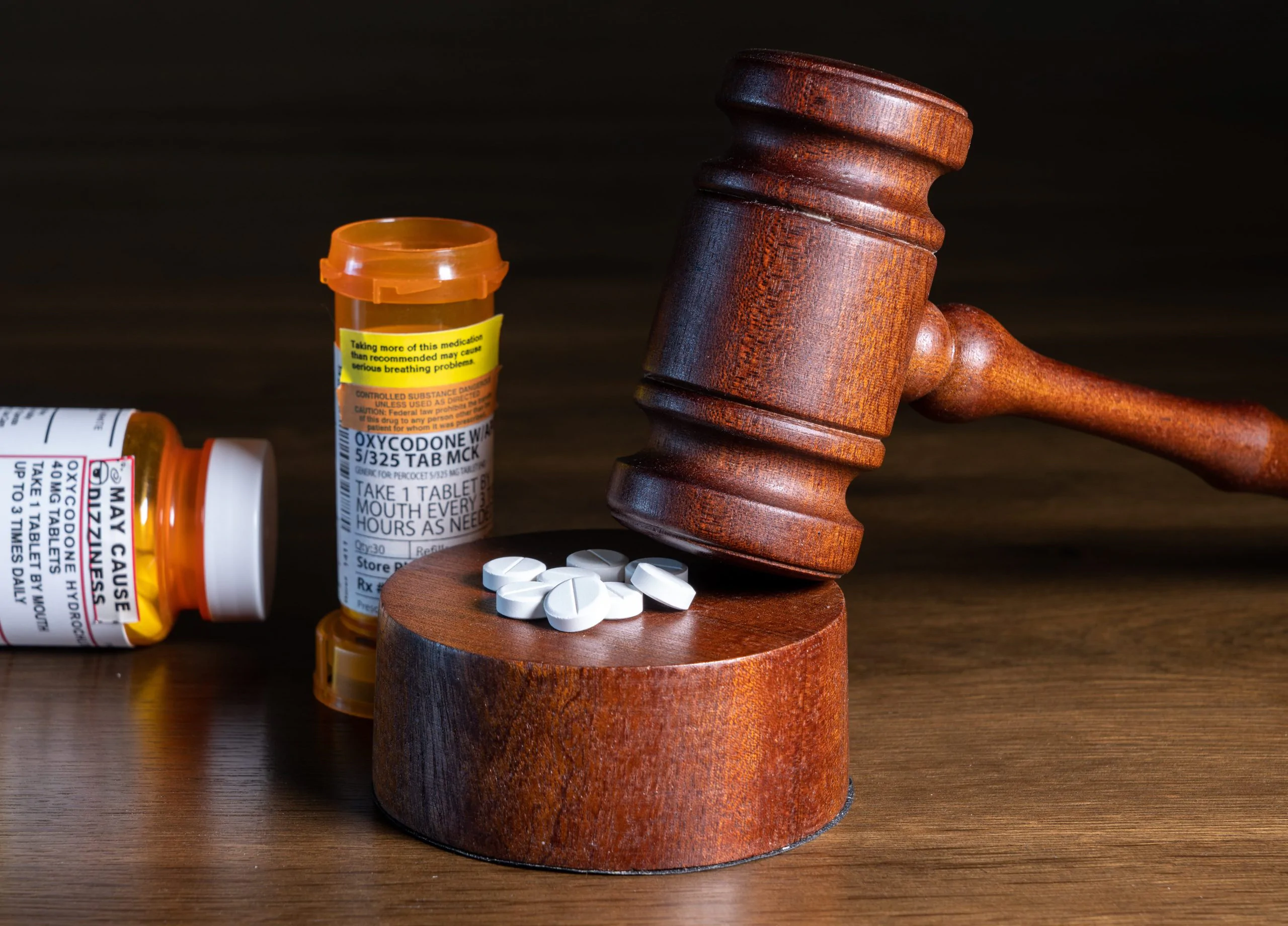The current, nation-wide opioid epidemic links back to the late 1990s when pharmaceutical companies started aggressively campaigning for their use. Opioid use, of course, is ancient. It’s misuse has a long history in the U.S. But the problem grew rapidly as opioids started to be marketed as a “miracle drug with pain-relieving effects, but their highly addictive properties were dangerously understated. Thousands of lawsuits have been filed against multi-million-dollar opioid manufacturers with various allegations of neglecting to convey the drugs’ true risks.
Patients sometimes form addictions to their opioid prescriptions and commonly resort to heroin as a cheaper, accessible alternative. Opioids can be safe when appropriately prescribed and administered, but prolonged use can result in addiction, injury, and death. Victims of addiction have filed personal injury lawsuits against hospitals and doctors who improperly distributed the drug. An opioid addiction lawsuit aims to recover damages sustained after deception leads to addiction.
What are Opioids?
Opioids are drugs that act on the nervous system to block pain signals in the brain. They relieve pain and induce a sense of euphoria, making them highly addictive and prone to recreational use. Many opioid addictions begin without any recreational intentions, where the medication prescribed by a doctor for legitimate purposes.
Opioids have a direct impact on brain function and cause serious harm with long term use. When prescribed as pain relievers, people often assume these drugs are safe to use under the direction of their doctor. The safe use of opioids depends on careful monitoring, minimally necessary use in terms of dosage and treatment duration and the careful observation by a physician. Without these precautions, addiction is possible, even likely.
Prescription Opioid Medications:
- Oxycodone (OxyContin, Oxaydo)
- Oxycodone and acetaminophen (Percocet, Roxicet)
- Hydrocodone (Hysingla ER, Zohydro ER)
- Morphine (Kadian, MS Contin, Morphabond)
- Methadone (Dolophine, Methadose)
- Hydromorphone (Dilaudid, Exalgo)
- Codeine
- Fentanyl (Actiq, Duragesic, Fentora, Abstral, Onsolis)
Due to the nature of these medications, patients often resort to taking more than prescribed. It can take only a few weeks for someone to become physically dependent on them. Many eventually turn to heroin, a natural opioid, as a cheaper means of satisfying their need for and later craving for the drugs.
Complications and Side Effects of Opioid Addiction
Painkillers and heroin can cause serious immediate and long-term complications with consistent use. While capable of controlling pain, negative side effects can affect a victim’s physical body and lead to further injury.
Short-term effects of opioid use:
- Drowsiness
- Confusion
- Elation/euphoria
- Nausea
- Constipation
- Slowed breathing/respiratory depression
- Intermittent loss of consciousness
Long-term effects of opioid use:
- Addiction/physical dependence
- Irregular heartbeat/higher risk of heart attack
- Severe stomach pain
- Hormonal imbalance
- Bone pain/weakness
- Depression
- Picking or scratching skin
The withdrawal symptoms of opioid addiction are painful and unpleasant. Opioid addicts can begin to experience withdrawal from as little as a few hours to a day after their last dose.
Withdrawal symptoms include:
- Diarrhea and vomiting
- Muscle and bone pain
- Excessive sweating
- Inability to sleep
- Dilation of pupils/blurred vision
- Rapid heartbeat
- High blood pressure
Opioids also have negative side effects in addition to addiction and physical dependency. As previously mentioned, opioids can cause changes in the brain that make the craving uncontrollable. In severe cases, victims may resort to a life of secrecy and stealing to fuel their addictions. Often, addicts experience noticeable changes in behavior and loss of interest in much of anything else besides their addiction.
Opioid Overdose
When overdosed on an opioid, people suffer from a change in their breathing cycle. Opioids slow breathing and will prevent healthy oxygen intake to the body and brain. A person will die if the brain cannot get sufficient oxygen to function. The amount of opioids that can cause an overdose depends on the particular opiate used and the individual’s body chemistry.
There is a higher risk for overdose when injecting opioids. Certain opioids, like fentanyl, pose a higher risk for overdose due to their potency in very small doses.
Trends and Statistics of Opioid Addiction in New York
In 2017, the United States declared a public health emergency in response to the opioid crisis. At the time, 91 Americans were dying every day from opioid use. To protect the people of New York, the New York State Department of Health initiated its Opioid Overdose Prevention Program. One of the main goals of this initiative is to track data on opioid addiction and opioid use disorders to identify struggling communities and intervene as needed.
Using historical and current data, the NYS Opioid Dashboard reveals that the following trends related to the misuse of opioids have “significantly worsened since 2010:
- Overdose deaths involving any opioid have increased
- All emergency department visits including any opioid overdose have increased
- Hospital discharges involving opioid use (including abuse, poisoning, dependence and unspecified use) have increased
- Admissions to drug dependence treatment programs for any opioid have increased
The 2019 NYS Opioid Annual Report specifies that New York has had a 200% increase in opioid overdose deaths from 2010 to 2017. The report states how “the opioid burden remains high, noting especially that over 62,000 New York State residents reported opioid use to the NYS Office of Alcoholism and Substance Abuse Services (OASAS) while receiving treatment.
Many residents of New York State know someone affected by opioid addiction. The stigma of addiction clouds the truth that it isn’t always the person’s fault for getting addicted. Pharmaceutical companies have manipulated their sales to profit from these drugs, contributing to the public health emergency our country still faces. To file a personal injury claim for your opioid addiction, you’ll have to build a strong case to prove negligence.
Opioid Lawsuits and Proving Negligence
Filing a claim for opioid addiction means holding someone else accountable for failing to provide critical information needed to make informed decisions. The first lawsuits in response to the opioid crisis were by state and local governments against manufacturing companies. These companies knew or should have known about the health risks of opioid treatment and were negligent to disclose them.
These multi-million-dollar companies have mostly avoided accountability until now. Various levels of state and local government continue to press charges, even holding distributors like Walgreens and CVS accountable. On a smaller scale, individuals have filed personal injury claims against their doctors for inadequately communicating the risks. The different legal approaches and arguments an individual may take depends on who is being held accountable.
Product Liability and the Case Against Pharmaceutical Companies
In April 2020, Governor Cuomo announced that New York will file charges against Mallinckrodt, the largest opioid manufacturer in the United States. The $500 million lawsuit accuses the opioid company of false advertising by:
Overstating the benefits of long-term opioid treatment
Understating the risks of addiction and abuse
Intentionally influencing conduct that would increase profit from unnecessary prescriptions
In October 2019 the makers of OxyContin, Purdue Pharma, agreed to pay $10 billion in damages in federal court, the largest settlement related to the opioid crisis to date. Purdue Pharma is filing for bankruptcy as part of its plan to pay state, local and tribal governments. State attorneys from five different U.S. territories were involved with this specific case.
The main allegation behind cases like this can be summed up to misleading marketing and product liability. In New York, every product manufacturer is liable for the product’s safety under product liability laws. Product liability laws state that a product with any health risks must have those risks disclosed. Companies like Mallinckrodt and Purdue Pharma knew that their products were not safe, yet claimed they were.
Prosecutors can further prove negligence by outlining the deceitful sales strategies that encourage doctors to overprescribe. Many doctors convince patients that their prescription is perfectly safe, while being bribed by pharmaceutical companies to fill more and larger prescriptions.
Malpractice and the Case Against Doctors
You trust your doctor to put your best interest first. Doctors and healthcare professionals in New York have a legal obligation to provide the best practice to their patients. If you developed an addition to your prescription, a medical malpractice claim may be made if your healthcare provider:
Overprescribed opioid medication
Failed to accurately inform you of associated health risks
Illegal prescription drug mills are run by doctors who prescribe unnecessary opioids. In 2018, the Drug Enforcement Administration (DEA) charged five New York doctors responsible for the wrongful distribution of more than 8.5 million oxycodone pills.
In cases such as this, the state Health Department’s Office of Professional Medical Conduct performs their own investigation for negligence. A doctor’s negligence in an opioid malpractice claim may include:
- Failure to maintain accurate patient records
- Failure to review patients’ medical histories and past opioid treatments
Though it has been difficult to prove over prescribing in the past, doctors have increasingly been held liable for committing malpractice and fueling opioid addiction.
The Case Against Pharmacies and Distributors
There are federal and state laws that mandate opioid distributors stop controlled substances from being put to illicit use. They are required to report suspicious prescribing patterns and any professional suspected of over prescribing. Despite the legal obligation, pharmacies have financial incentive to turn a blind eye and have been sued for such negligence.
An example of distributor negligence is when the Center for Disease Control (CDC) released data in 2012 revealing that some states had more prescriptions than people. At that point, people are blatantly neglecting their responsibility to monitor and investigate prescriptions on behalf of public health.
Statute of Limitations for Opioid Related Personal Injury Claims
In New York, the statute of limitations for product liability and negligence resulting in personal injury is three years. This means you have three years from the date of injury to take legal action.
The statute of limitations for medical malpractice is 2 years and 6 months from the date of malpractice or from end of continuous treatment.
In the case of wrongful death or overdose, the statute of limitations is 2 years from death.
Opioid and medical malpractice cases commonly apply the rule of discovery. This mean that the three year statute of limitations begins from the time injury was or should have been discovered. Hiring an experienced opioid lawyer will help ensure you meet critical deadlines.
Making a Claim Against Purdue Pharma
The Purdue Pharma case has established a deadline for victims of Oxycontin to assert legal damages against the company before filing bankruptcy. All claims seeking compensation must be filed by June 30, 2020 at 5:00 Eastern Time. Click here for help filing a proof of claim with Purdue Pharma within their strict deadlines. You can file the proof of claim by yourself or with an experienced attorney.
Individual Opioid Lawsuits: Damages and Compensation
Victims of opioid addiction may be able to recover damages such as:
- Medical expenses covering:
- Hospitalization and medical transport
- Substance dependency treatments and rehabilitation
- Medications such as Narcan
- Legal expenses related to previous arrests linked to opioid addiction
- Lost wages from missing of work whether from:
- Hospitalization
- Attending rehab
- Serving a prison sentence
- Future lost wages due to loss of income after sustaining permanent disabilities related to a drug overdose
- Funeral expenses
- Pain and suffering by either the victim or family members
How Hiring a Lawyer Can Help
Hiring a lawyer to assist you in an opioid addiction personal injury lawsuit can help ensure you’re making a strong claim. A lawyer will thoroughly investigate the circumstances of your opioid-related injury and help identify any party that may have contributed to your addiction. The goal is to claim damages from all liable parties and fully assess your injuries to maximize compensation. An experienced lawyer will know how to communicate with manipulative insurance and pharmaceutical companies on your behalf.
Opioid lawyers at Sobo and Sobo have years of experiences serving clients in the Hudson Valley and the Bronx. Contact them today for a free consultation. Speak with an experienced legal team ready to take on your case and help you move forward.




